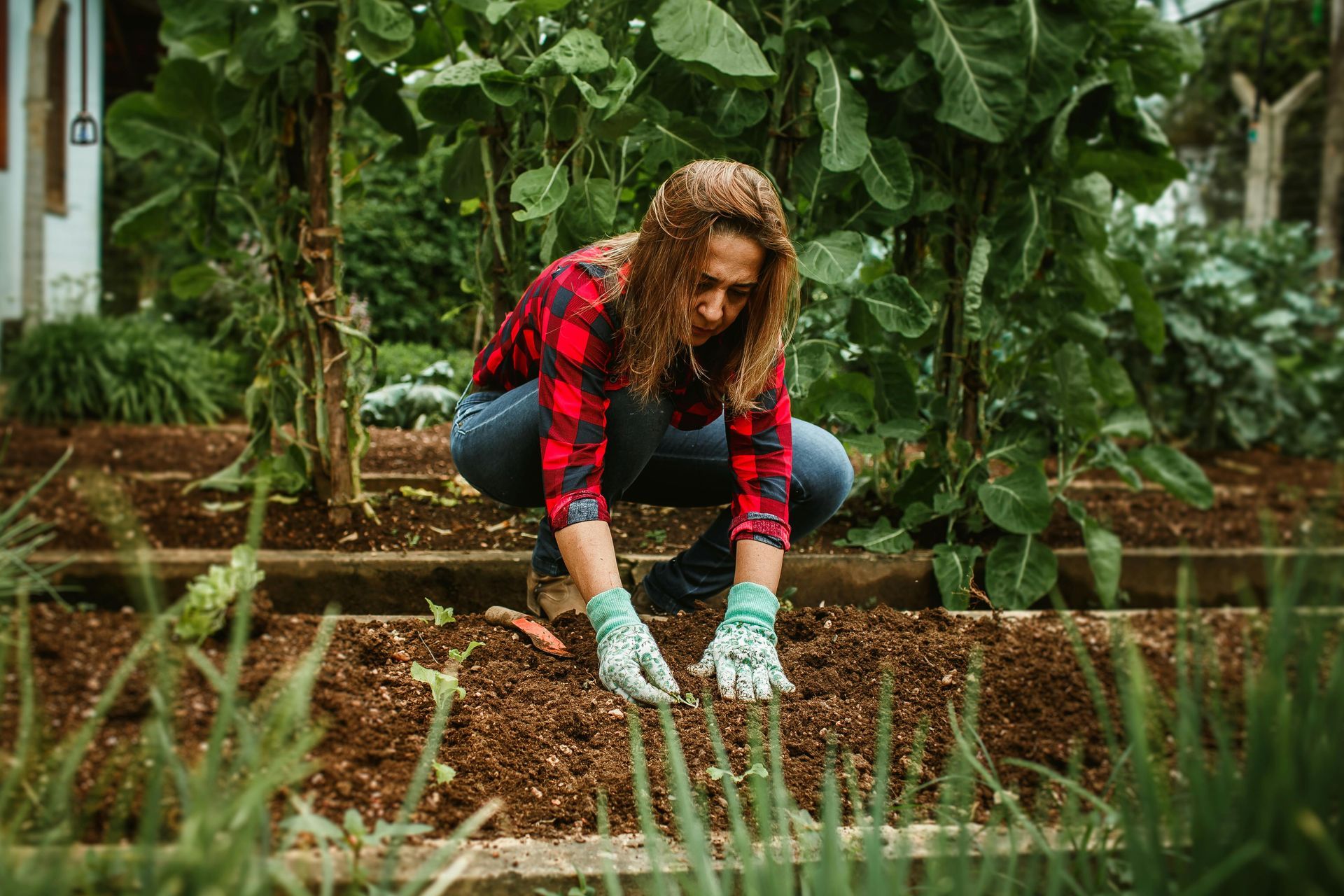Soil Testing: What It Is and Why You Need It
You're doing everything right-- watering, fertilizing, staking, spraying, planting at just the right time in the season-- yet for some reason your garden isn't producing the way you thought it would. Or perhaps your houseplants just aren't ~thriving~ like everyone else's, but instead are yellow, lanky, or just plain sad-looking. You may ask yourself, "what am I doing wrong?!"
In truth, it may not be what you are doing, but what you're not doing. No matter what kind of soil you buy or have naturally on your property, without proper maintenance it can lose its ability to sustain healthful plant life. Overtime, the macro- and micronutrients are sequestered by the resident plant life, leaving your once rich, fertile soil as dusty as the Oklahoma prairies. This is especially true on farms that cycle the same few crops over and over, leaching the soil of those macro- and micronutrients and altering the composition, resulting in unbalanced, infertile, dusty soil.
So, what do we do to fix this? How do we know that the problem is empty soil and not something else? We test our soil!

What is soil testing?
Soil testing is the process of analyzing soil samples to determine their composition and health and is a fundamental practice for anyone looking to maintain healthy and productive gardens, farms, or landscapes. These tests provide critical information about the soil’s nutrient levels, pH, organic matter content, and the presence of contaminants, all of which can impact plant growth, crop yields, and environmental sustainability. Whether you decide to leave it to a professional laboratory or do-it-yourself with an at-home kit, soil testing is the first step toward achieving a thriving, sustainable garden or farm.
What do soil tests look at?
1. Nutrient Levels
- Identify Deficiencies: Soil tests reveal the levels of essential nutrients like nitrogen, phosphorus, and potassium, which are vital for plant growth. They identify specific deficiencies and should provide you with an actionable plan to restore balance to the soil.
- Optimize Fertilization: Knowing the nutrient content allows you to apply the correct type and amount of fertilizer, preventing over-fertilization or under-fertilization.
2. Soil pH
- Determine Acidity or Alkalinity: The pH level of your soil affects nutrient availability. Some plants thrive in acidic soils, while others prefer alkaline conditions. Testing helps you adjust the pH to suit your plants.
- Improve Plant Health: Correct pH levels ensure that plants can absorb nutrients efficiently, leading to better growth and yields.
3. Soil Composition
- Texture and Structure: Soil tests can analyze the proportions of sand, silt, and clay, helping you understand the soil’s drainage and aeration properties.
- Amendments: Knowing your soil’s composition allows you to make amendments, such as adding organic matter, to improve its structure and fertility.
4. Contaminants
- Check for Toxins: Soil tests can detect harmful contaminants like lead, arsenic, or pesticides, which can pose risks to health if you’re growing edible plants.
- Safe Gardening: Identifying contaminants ensures that your garden is safe for growing food or for general use.
5. Water Retention and Drainage
- Assess Moisture Levels: Testing can help determine how well your soil retains water, which is crucial for plant health, especially in areas prone to drought or heavy rain.
- Prevent Root Rot: Understanding your soil’s water-holding capacity helps in managing irrigation and preventing waterlogged conditions that can lead to root diseases.
6. Plant-Specific Needs
- Tailored Soil Management: Different plants have unique soil requirements. Testing allows you to tailor the soil conditions to meet the specific needs of the plants you want to grow.
- Better Crop Yields: By optimizing soil conditions for specific plants, you can enhance crop yields and overall garden productivity.
7. Long-Term Soil Health
- Monitor Soil Changes: Regular soil testing helps you track changes in soil health over time, enabling you to maintain its fertility and structure.
- Sustainable Gardening: Understanding your soil’s condition promotes sustainable gardening practices, reducing the need for synthetic inputs.
What are the benefits of soil testing?
- Optimizes plant growth. By understanding the soil's nutrient levels and pH, you can tailor your soil management practices to ensure optimal plant growth.
- Prevents over-fertilization. Testing helps avoid the overuse of fertilizers, which can be harmful to plants and the environment.
- Improves crop yields. Farmers can increase crop yields by addressing specific soil deficiencies identified through testing.
- Promotes environmental sustainability. Soil testing helps manage land in a way that conserves resources and reduces environmental impact.
Where can I get my soil tested?
Luckily, there are plenty of options for those that want to get their soil tested. This list is not exhaustive, but it is enough to give you a head start in your research.
1. Penn State Extension Soil Testing Program
- Penn State Extension offers soil testing services for homeowners and gardeners.
- You can pick up a soil test kit at your local Penn State Extension office or order one online. The kit includes instructions on how to collect and submit your soil sample.
- Penn State Extension has offices in every county in Pennsylvania, including the Southeastern region (e.g., Bucks, Chester, Delaware, Montgomery, and Philadelphia counties).
2. Local County Extension Offices
- County extension offices often provide soil testing kits and can offer advice on how to collect samples. They usually send the samples to a university lab for analysis.
- Each county in Southeastern Pennsylvania has an extension office. You can find your local office by visiting the Penn State Extension website and searching by county.
3. Private Soil Testing Labs
- Several private laboratories offer soil testing services. These labs typically provide more detailed reports and may offer additional tests (e.g., testing for contaminants).
- Examples of Labs:
- Logan Labs (Ohio-based, accepts mail-in samples)
- A&L Eastern Laboratories (Richmond, VA)
- You can usually mail your soil samples to these labs after following their specific collection guidelines.
4. Local Nurseries and Garden Centers
- Some nurseries and garden centers in the region partner with labs to offer soil testing services. They may provide kits, help with sample collection, and send the samples for analysis on your behalf.
- Check with local garden centers like Primex Garden Center in Glenside, PA, or Waterloo Gardens in Exton, PA, to see if they offer soil testing.
5. Conservation Districts
- Some county conservation districts offer soil testing services, particularly for farmers and larger-scale gardeners. They may also provide advice on soil management and conservation practices.
- Contact your county's conservation district office for more information.
6. Community Gardens and Environmental Organizations
- Some community gardens and environmental organizations in Southeastern Pennsylvania offer soil testing as part of their services, especially for urban gardens where soil contamination may be a concern.
- The Pennsylvania Horticultural Society (PHS) may offer testing services or provide resources to get your soil tested.
7. Home Testing Kits
- If you're interested in a more basic understanding of your soil's pH and nutrient levels, you can purchase an at-home soil testing kit from garden centers or online retailers like Amazon or Home Depot. While these kits are less comprehensive than lab tests, they can provide quick insights and actionable plans to help balance your soil.
What to expect from your soil test results
No matter where you go to get your soil tested, there are a few pieces of information that you should receive. This will likely vary from test to test, as some places offer basic packages with buyable add-ons which include more complex parameters. However, these are the most common parameters:
- Nutrient analysis. Tests often measure the levels of essential macronutrients like nitrogen (N), phosphorus (P), and potassium (K), which are vital for plant growth. Some tests also assess levels of secondary nutrients and micronutrients, such as calcium, magnesium, sulfur, iron, and zinc.
- pH measurement. The pH level indicates how acidic or alkaline the soil is, which affects the availability of nutrients to plants. Most plants prefer a pH between 6 and 7, but specific plants may require more acidic or alkaline conditions.
- Soil texture and structure. Soil tests can determine the proportions of sand, silt, and clay in the soil, which affect its texture, drainage, and aeration abilities. Understanding the soil’s structure helps in improving its physical properties, like water retention and root penetration.
- Organic matter content. The amount of organic matter in the soil is crucial for soil fertility. It influences water retention, nutrient supply, and soil structure.
- Contaminant detection. Soil tests can identify contaminants such as heavy metals (e.g., lead, arsenic), pesticides, or other pollutants that could be harmful to plants, animals, and humans.
- Recommendations for soil management. Based on the test results, specific recommendations should be provided for adding fertilizers or soil amendments to correct nutrient deficiencies or imbalances. The test may suggest adding lime to raise pH or sulfur to lower it, depending on the soil's current acidity or alkalinity. Other suggestions might include adding organic matter, improving drainage, or taking steps to remediate contamination.
How to do an at-home soil test
Using an at-home soil testing kit is a straightforward process that allows you to quickly assess your soil's pH, nutrient levels, and sometimes other factors like moisture or contaminants. Many people opt for this method as it is a cost-effective way to get immediate feedback on your soil’s condition, allowing you to make informed decisions to promote healthy plant growth. Here’s a step-by-step guide on how to use a typical at-home soil testing kit, although some aspects may vary based on your particular testing kit:
1. Choose the right kit for you
- Kits usually test for pH, nitrogen (N), phosphorus (P), and potassium (K). Some kits may also include tests for other nutrients or soil properties.
- Before purchasing, ensure the kit tests for the parameters you’re interested in and that you understand the instructions.
2. Gather necessary supplies
- Your kit should include test containers, color comparison charts, and chemical reagents or test strips.
- You’ll need a clean trowel or shovel, a container for mixing soil, and distilled water (not tap water, as it can affect results).
3. Collect your soil samples
- Choose several spots in your garden to get a representative sample. Avoid areas that are heavily fertilized or treated with chemicals.
- Dig 4-6 inches deep for garden beds or 2-3 inches for lawns. Remove any surface debris like grass, leaves, or mulch.
- Combine the soil from the different spots into one container and mix it well. This creates a composite sample that represents your garden’s overall soil condition.
- Remove any stones, roots, or large organic material from the sample.
4. Prepare the test
- The instructions will tell you how much soil to use and whether to add water. Usually, you’ll mix soil with distilled water to create a soil slurry.
- Use the provided tools (like a scoop or dropper) to measure soil and water. Mix them thoroughly according to the kit’s instructions.
5. Perform the test
- For pH, you might add the soil slurry to a test container with a chemical reagent or use a pH strip. Shake or stir as instructed, then wait for the solution to change color.
- Similar to the pH test, you’ll add soil or soil slurry to different containers for nitrogen, phosphorus, and potassium tests. Add the reagent, shake or stir, and wait for the color to develop.
- Follow the specific timing instructions for each test, as waiting too long or not long enough can affect accuracy.
6. Interpret and record the results
- Match the color of your test solution to the color chart provided in the kit. This will indicate your soil’s pH or nutrient levels.
- Write down the results for each test so you can reference them later when planning soil amendments.
7. Take action based on the results
- If your pH is too low (acidic), add lime to raise it. If it’s too high (alkaline), add sulfur or organic matter to lower it.
- Based on nutrient levels:
- Low Nitrogen: Add compost, manure, or a nitrogen-rich fertilizer.
- Low Phosphorus: Use bone meal, rock phosphate, or a phosphorus-rich fertilizer.
- Low Potassium: Add potash, wood ash, or a potassium-rich fertilizer.
- After making adjustments, re-test your soil in a few weeks or months to see if conditions have improved.
8. Maintain your soil
- Test your soil at least once a year to monitor changes and adjust your soil management practices as needed.
- Keep a log of your test results and any amendments you apply. This will help you track your garden’s progress over time.
Conclusion
Soil testing is an essential tool for anyone committed to cultivating healthy, productive land. By understanding your soil's nutrient composition, pH levels, and potential contaminants, you can make informed decisions that lead to better plant growth, increased crop yields, and more sustainable land management. Whether you're a homeowner, gardener, or farmer, regularly testing your soil provides the insights needed to optimize soil conditions, tailor fertilization, and ensure the long-term health of your land. With the right approach to soil testing, you can unlock the full potential of your soil and create a thriving environment for your plants and crops.
Check out the latest...








